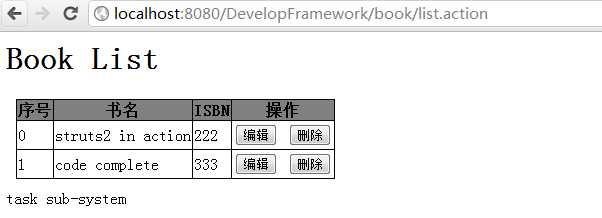struts2的resultType
struts2定义了多种resultType,包括dispatcher和redirectAction等
在struts-default.xml文件中,定义了所有的resultType类型
有空可以跟进去看看源码
本文重点说的是默认的dispatcher和redirectAction的区别

这里点击“删除”,会执行一段javascript代码:
关键就是会跳转到delete.action?id=xxx这个URL,进入Action的delete()方法
此时struts.xml的配置是这样的:
代码很简单,就不解释了。功能可以实现,不过有个问题,就是用这种配置方式,删除操作之后,URL是这样的:

这时用户如果用F5刷新浏览器,就会发生重复提交的问题。所以可以这样修改,将resultType改成redirectAction
这样执行完delete.action后,会跳转进list.action,所以delete()方法也可以删除一行代码
实际看点击“删除”按钮的前后URL对比


实现了我们的目的
总结来说,默认的resultType是dispatcher,一般用来处理jsp跳转。如果希望一个action执行之后进入另一个action,可以用redirectAction,如果要多个action共同响应一个请求,可以用chain
最后补充一点,通过redirectAction进入新的Action,会新创建一个Action的实例
输出结果:
after redirectAction, currentBook is null or not
currentBook is null
在struts-default.xml文件中,定义了所有的resultType类型
<result-types>
<result-type name="chain" class="com.opensymphony.xwork2.ActionChainResult"/>
<result-type name="dispatcher" class="org.apache.struts2.dispatcher.ServletDispatcherResult" default="true"/>
<result-type name="freemarker" class="org.apache.struts2.views.freemarker.FreemarkerResult"/>
<result-type name="httpheader" class="org.apache.struts2.dispatcher.HttpHeaderResult"/>
<result-type name="redirect" class="org.apache.struts2.dispatcher.ServletRedirectResult"/>
<result-type name="redirectAction" class="org.apache.struts2.dispatcher.ServletActionRedirectResult"/>
<result-type name="stream" class="org.apache.struts2.dispatcher.StreamResult"/>
<result-type name="velocity" class="org.apache.struts2.dispatcher.VelocityResult"/>
<result-type name="xslt" class="org.apache.struts2.views.xslt.XSLTResult"/>
<result-type name="plainText" class="org.apache.struts2.dispatcher.PlainTextResult" />
</result-types>
有空可以跟进去看看源码
本文重点说的是默认的dispatcher和redirectAction的区别

这里点击“删除”,会执行一段javascript代码:
$(document).ready(function() {
$(".delete_book").click(deleteBook);
});
function deleteBook() {
var $deleteButton = $(this);
var $idSpan = $deleteButton.parent().find(".hidden_book_id");
var bookId = $idSpan.text();
var url = "delete.action?id=" + bookId;
window.location.href = url;
}
关键就是会跳转到delete.action?id=xxx这个URL,进入Action的delete()方法
@Autowired
private IBookService bookService;
private List<Book> books;// 书籍列表
private String id;// 接收客户端传值
public String list() {
books = bookService.getAllBooks();
return SUCCESS;
}
public String delete() {
bookService.deleteBookById(id);
books = bookService.getAllBooks();
return SUCCESS;
}
此时struts.xml的配置是这样的:
<package name="bookManage" extends="struts-default" namespace="/book"> <action name="list" class="bookAction" method="list"> <result name="success">../jsp/bookManage/bookList.jsp</result> </action> <action name="delete" class="bookAction" method="delete"> <result name="success">../jsp/bookManage/bookList.jsp</result> </action> </package>
代码很简单,就不解释了。功能可以实现,不过有个问题,就是用这种配置方式,删除操作之后,URL是这样的:

这时用户如果用F5刷新浏览器,就会发生重复提交的问题。所以可以这样修改,将resultType改成redirectAction
<package name="bookManage" extends="struts-default" namespace="/book"> <action name="list" class="bookAction" method="list"> <result name="success">../jsp/bookManage/bookList.jsp</result> </action> <action name="delete" class="bookAction" method="delete"> <result name="success" type="redirectAction">list.action</result> </action> </package>
这样执行完delete.action后,会跳转进list.action,所以delete()方法也可以删除一行代码
@Autowired
private IBookService bookService;
private List<Book> books;// 书籍列表
private String id;// 接收客户端传值
public String list() {
books = bookService.getAllBooks();
return SUCCESS;
}
public String delete() {
bookService.deleteBookById(id);
return SUCCESS;
}
实际看点击“删除”按钮的前后URL对比


实现了我们的目的
总结来说,默认的resultType是dispatcher,一般用来处理jsp跳转。如果希望一个action执行之后进入另一个action,可以用redirectAction,如果要多个action共同响应一个请求,可以用chain
最后补充一点,通过redirectAction进入新的Action,会新创建一个Action的实例
public String list() {
System.out.println("after redirectAction, currentBook is null or not");
if (null == currentBook) {
System.out.println("currentBook is null");
} else {
System.out.println("currentBook is not null");
}
books = bookService.getAllBooks();
return SUCCESS;
}
<action name="delete" class="bookAction" method="delete"> <result name="success" type="redirectAction">list.action</result> </action>
输出结果:
after redirectAction, currentBook is null or not
currentBook is null